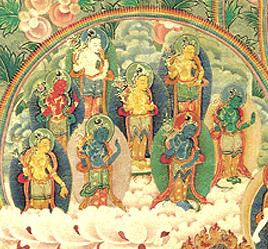Five paths

Five paths (Skt. pañcamārga; Tib. ལམ་ལྔ་, lam nga, Wyl. lam lnga) — a succession of five stages or paths describing the entire spiritual journey towards liberation. They appear with similar names in both the Basic yana (Sarvastivadin and Sautrantika schools) and Mahayana but their interpretation is considerably different.[1]
They are:
- the path of accumulation (Skt. sambhāramārga)
- the path of joining (also called 'engagement' or 'junction') (Skt. prayogamārga)
- the path of seeing (or 'insight') (Skt. darśanamārga)
- the path of meditation (or 'cultivation') (Skt. bhāvanāmārga)
- the path of no-more-learning (Skt. aśaikṣamārga)
Progression on the Five Paths According to the Mahayana Tradition
In the Mahayana, the five paths describe the entire spiritual journey, from its very beginnings with the taking of the bodhisattva vow and the generation of relative bodhichitta, up until its culmination at the stage of complete enlightenment.
Along the first four of the five paths, the thirty-seven factors of enlightenment are undertaken and perfected, and present thereafter as qualities of enlightenment.
There is also a correspondence between the five paths and the ten bhumis.
The chart below summarizes the details of this progression and its various correspondences.[2]
| paths | progress | subdivisions | factors of enlightenment | bhumis |
|---|---|---|---|---|
| 1. accumulation | taking the bodhisattva vow; special effort to gather the accumulation of merit | lesser | four applications of mindfulness | ordinary bodhisattva |
| intermediate | four genuine restraints | |||
| greater | four bases of miraculous powers | |||
| 2. joining | increase of wisdom | warmth | five powers | |
| summit | ||||
| acceptance | five strengths | |||
| supreme attribute | ||||
| 3. seeing | direct realisation of absolute bodhicitta; becoming an arya bodhisattva | seven elements for enlightenment | first bhumi | |
| 4. meditation | meditation on the truth realized on the path of seeing; according to the tradition of Asanga, there are four hundred and fourteen discards to be relinquished on this path | noble eightfold path | second to tenth bhumis | |
| 5. no-more-learning | complete enlightenment is reached when the most subtle cognitive obscurations are overcome by means of what is called the “vajra-like samadhi”; omniscience of a samyaksam-buddha | complete Enlightenment, eleventh bhumi |
It is said in the pith instructions that the path of accumulation is the stage of understanding, the path of joining is the stage of experience, and the path of seeing is the stage of realization.[3]
Canonical Literature
Sutras
Shastras
References
- ↑ Philippe Cornu, Dictionnaire encyclopédique du bouddhisme (Paris: Éditions du Seuil, 2001), page 708.
- ↑ Sources: Zindri, pages 229-330; individual wiki articles on each of the five paths; Philippe Cornu, Manuel de bouddhisme — Philosophie, pratique et histoire. Tome II, Bouddhisme Mahāyāna (Editions Rangdröl, 2019), pages 44-46.
- ↑ Source needed.